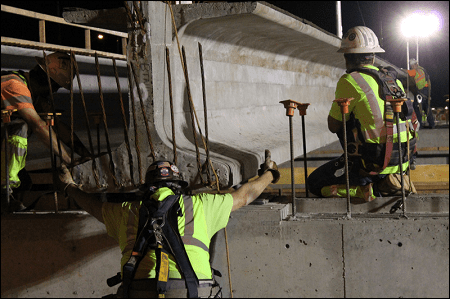In an overhaul of the infrastructure grant program authorized by the five-year Fixing America’s Surface Transportation Act, the U.S. Department of Transportation said it will take new applications over the next four months for about $710 million in 2017 grants, and combine those with the 2018 round for what it estimates will add up to $1.56 billion in all.
The overhaul includes new application criteria, with a strong emphasis on maximizing the use of federal grant money to draw in other funds from state, local and private sources along with USDOT loan programs. That is in line with a recurring theme of President Trump’s still-forming infrastructure investment proposal – to use $200 billion in direct federal funding over 10 years to leverage $1 trillion in total project investment.
But since project sponsors had already submitted applications for the 2017 funding, the program reboot delays distribution of this year’s grant funds and will force many sponsors to alter and resubmit their proposals.
Last fall under the previous administration, the USDOT took applications through Dec. 15 for $850 million in what it called Fastlane grants, which the FAST Act authorized for projects of regional and national significance and those that improve the flow of freight shipments.
That authorized amount, though, is subject to annual obligation limits for federal-aid highway funds, which the USDOT said cut the actual value of available 2017 grant funds to $788.8 million.
Now, the USDOT said it intends to soon award $78.8 million or 10 percent of the total to small projects from last fall’s group of applications, but is altering the project application criteria for the large-project 2017 grants and all applications for subsequent years.
It is also rebranding the program to call them INFRA grants, which stands for “Infrastructure for Rebuilding America.”
It is combining in a new, 120-day solicitation the remaining $710 million in 2017 funds with the scheduled $900 million authorized round for 2018. After annual obligation limits the 2018 total should end up as $810 million to $855 million, the USDOT estimated in a formal notice of funding opportunity, for a total two-year award pool of perhaps $1.56 billion.
It added that the “estimate may be higher or lower than the final amount,” depending on future appropriations legislation, and that “any award under this notice will be subject to the availability of funds.”
That timing – four months to take applications, plus time for officials to review them and choose which projects to award – means that when the bulk of 2017 grant funds are finally awarded the money will be made available past the 2017 construction season for many states.
In addition, state DOTs and other stakeholders are waiting for the USDOT to open the application process for $500 million in the department’s separate TIGER infrastructure grant program, which Congress approved this year in addition to the FAST Act program.
Industry sources said they are hoping the USDOT, which is still staffing up under the new administration, will offer the 2017 TIGER grants sometime this summer.
In a June 29 press release, the USDOT said its INFRA program “utilizes updated criteria to evaluate projects to align them with national and regional economic vitality goals and to leverage additional non-federal funding. The new program will increase the impact of projects by leveraging capital and allowing innovation in the project delivery and permitting processes, including public-private partnerships.”
The new application criteria, it said, include “innovative safety solutions that will improve our transportation system,” performance and accountability in both project delivery and operations.
“The president and the department are committed to revitalizing, repairing and rebuilding America’s aging infrastructure,” said USDOT Secretary Elaine Chao. “By ensuring the right incentives, projects selected under this program will be better able to make significant, long-term improvements to America’s transportation infrastructure.”
In the 56-page funding opportunity notice, the USDOT gave examples of types of projects it is looking to support.
Those include projects that “achieve a significant reduction in traffic fatalities and serious injuries on the surface transportation system,” those that “improve interactions between roadway users,” eliminate freight movement bottlenecks and “ensure or restore the good condition of infrastructure that supports commerce and economic growth.”
It also said: “The Department anticipates that applications for networks of projects are likely to align well with this evaluation criterion because networks of projects often are able to address problems on a broader scale.”
As to leveraging the federal dollars to woo more funding from elsewhere, the USDOT said that “an application that proposes a 20 percent federal share will be more competitive than an otherwise identical application proposing 50 percent federal share.”
It noted that it will include loans from the USDOT’s TIFIA and RRIF (rail) loan programs to count as non-federal funds, and will take into account applications that have less opportunity for as much non-federal funding such as rural-area projects.
The USDOT will also look at applicants’ plans to manage assets’ life-cycle costs. The notice said the department “will consider how well the applicant has prepared for future operations and maintenance costs associated with their project’s life cycle. Applicants should demonstrate a credible plan to maintain their asset without having to rely on future federal funding.”


